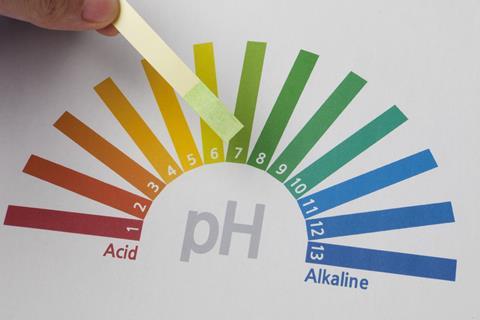Eric Scerri takes on the idea that pH 7 and neutral always coincide, and explains why it doesn't necessarily tell the whole story

The notion that pH 7 is always neutral and that neutral is always pH 7 is prevalent in the classroom, especially when the subject is treated qualitatively. But once the concept of Kw and its value of 10−14 is introduced, it becomes problematic.
Kw is the dissociation constant for water – the concentration of hydrogen ions multiplied by that of hydroxide ions (Kw = [H+][OH−]) – which is, at room temperature, 1 × 10−14 mol−2 dm−6. pH is calculated by replacing the [OH−] by another [H+] as the concentrations of hydrogen and hydroxide are equal. Then, [H+]2 = 1 × 10−14. Taking the square root of each side gives [H+] = 1 × 10−7 mol dm−3 and pH = −log10 [H+], pH = 7.
The problem is the notion that having a pH of 7 is both necessary and sufficient for neutrality to occur. In fact, it is neither necessary nor sufficient for a solution to be pH 7 for it to be neutral.
Necessary and sufficient
Establishing necessary and sufficient conditions ensures that a causal link between any two concepts can be specified. For example, is the act of smoking cigarettes necessary and/or sufficient for contracting lung cancer? If smoking led to lung cancer, it would mean that smoking is sufficient to cause the disease in anyone, but this is not the case. Conversely, you could ask whether people with lung cancer have smoked, but there can be many possible causes of the disease and smoking is only one of them. So smoking is not a necessary or sufficient cause, although there is a high correlation between a person smoking and the probability of their contracting the disease.
Another chemistry-based example: if an atom contains 79 protons, it must be gold. Conversely, for any atom to be gold its nucleus must contain 79 protons. Having a particular number of protons is both necessary and sufficient to ensure the identity of any element.
pH 7 is not always neutral
With acids and bases, the lack of sufficiency is easy to establish by determining whether a pH of seven implies that a solution is neutral. The answer is no, since what defines a neutral solution is the presence of an equal number of moles of H+ and OH− ions, a situation that may occur at any pH value. For example, you could have a solution of just H+ ions at a concentration of 10−7 mol L−1 but this would clearly not be neutral. We must abandon the idea that it is sufficient for a solution to be pH 7 for it to be neutral.
Neutral is not always pH 7
Conversely, if a solution is neutral, that does not guarantee that it is also at pH 7. For example, at a temperature of 50oC, Kw = 5.47 × 10−14, giving a pH of 6.63. Temperature affects the equilibrium of the reaction of water dissociating into hydrogen and hydroxide ions. The process is endothermic, so the forward reaction absorbs heat. Increasing the water’s temperature favours the forward reaction and more hydrogen ions and hydroxide ions are formed, raising the value of Kw and lowering the pH. Nevertheless, the solution is still neutral, since whatever the temperature, the self-ionization of water results in equal amounts of H+ and OH− ions. The implicit notion that it is also necessary for a solution to be pH 7 for it to be neutral is inherited from elementary chemistry and must be unlearned at college level.1
Although the points I am making here are not particularly original, I believe that the use of necessary and sufficient conditions to clarify the situation may represent a new contribution to teaching about pH and neutrality.
References
- Another related false notion to do with pH is that the range of possible values runs from 1 to 14. These limits can easily be exceeded in cases of 1 M or 10 M solutions of strong acids (pH = 0 and −1 respectively) or 10−15 M, which yields a pH of 15, pH values that novice chemistry students initially find rather shocking.
Five ideas in chemical education that must die
- 1
- 2
 Currently reading
Currently readingpH 7 is neutral
- 3
- 4
- 5
- 6




![I stock 000036213086 300tb[1]](https://d1ymz67w5raq8g.cloudfront.net/Pictures/100x67/5/7/8/113578_istock_000036213086_300tb1.jpg)
![Shutterstock 195864272 300tb[1]](https://d1ymz67w5raq8g.cloudfront.net/Pictures/100x67/6/3/8/113638_shutterstock_195864272_300tb1.jpg)

![Group 3 myths i stock 000005756628 300tb[1]](https://d1ymz67w5raq8g.cloudfront.net/Pictures/100x67/5/7/9/113579_group3myths_istock_000005756628_300tb1.jpg)




2 readers' comments